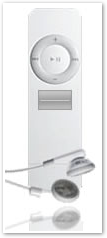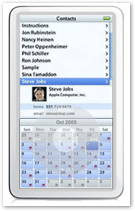

The iPod turns five years old this fall, and is due for its annual revamping. Apple keeps a tight lid on future plans, but here's a look at three designs for Generation 6 iPods, along with three software features I’d like to see Apple deliver.
ideas for New iPods



Apple has done a pretty good job in balancing the iPod's features and simple usability. In some cases, they've withheld features that would unnecessarily complicate the device.
Beyond the obvious demands for things like longer battery life and larger displays, there are a few nagging issues that I'd like to see addressed in the iPod software:
Make Notes more useful. Nobody uses Notes, but they are a cool idea waiting to be improved upon. Essentially, they are just text files that can use HTML tags to create hyperlinked, mini webpages that can reference and play songs and other media.
 Apple doesn't provide any tools to create Notes, and there isn't an easy way to distribute Note collections that other can easliy install; they have to drag files to their iPod’s Notes folder manually.
Apple doesn't provide any tools to create Notes, and there isn't an easy way to distribute Note collections that other can easliy install; they have to drag files to their iPod’s Notes folder manually. Apple should integrate Notes editing into iWeb, add page capacity (Notes can't get very big), and improve upon how Notes are installed.
A reader pointed out a thrid part Notes editor called iWriter from Talking Panda. It looks pretty cool.
Display PDF on the iPod. I don't know if this is a difficult request, but I'd like to see support for graphic format that could incorporate hyperlinks and offer a bit more sophistication than gif files.


 DJ speed control playback. Apple has the tech to change playback speed for spoken content at the same pitch. How about playback pitch control and beat matching for DJs? I'd like to scratch my songs and scrub my video using the click wheel as a jog/shuttle control. It would certainly be more fun than a game of iPod breakout.
DJ speed control playback. Apple has the tech to change playback speed for spoken content at the same pitch. How about playback pitch control and beat matching for DJs? I'd like to scratch my songs and scrub my video using the click wheel as a jog/shuttle control. It would certainly be more fun than a game of iPod breakout. Beyond general software requests, I've come up with three iPod lines that would target the iPod at specific users and needs:
 iPod Shuffle ID
iPod Shuffle ID This simple iPod device, based on the Shuffle, would incorporate a unique HASP type GUID key and a thumbprint scanner. Designed for mobile users, the Shuffle ID could be used to login to a computer, unlock encrypted files, and authenticate secure transactions or VPN connections.
Rather than having the user remember a secure password, the Shuffle ID would serve as an electronic key device, as well as a fingerprint identity verifier. Users wouldn't need to safeguard their password or access to the device, since it would require the physical presence of both the user and the device to work. Once the Shuffle ID was unplugged, the system could be set to force a logout, and encrypt and close all open data files.
Companies could issue Shuffle IDs to their employees to secure access to their computers, and the files on them. They could also set up policies that would, for example, turn off a system's iSight camera or wireless networking if they work in a secured area. Being built into a Shuffle would make the ID key a cool perk, and make employees more like to keep it handy.
Security hardware features are already built into Mac OS X; this device would simply enable them and make the Mac OS X platform more secure and attractive to professional users.
The Shuffle ID uses simple, cheap, and readily available hardware devices. It would be inexpensive, and wouldn't compete with the functionality of full sized iPods. It would also differentiate the low end iPod Shuffle from other flash players, adding value to the low end.
iPod Pro
The iPod Pro is an iPod designed for business users. It includes support for wireless data via a card slot, so users can buy the type of wireless service they need: WiFi Airport wireless, EDGE, or a Bluetooth dialup networking uplink to connect to the user's mobile phone. It features four main functions:

-
•SMS messaging, IM, and Email;
-
•Enhanced calendar and contacts, with desktop support for iSync and Outlook;
-
•Access to PDF documents.
-
•An integrated web browser
It would sport a virtual thumb pad keyboard for text messaging, enabling it to handle the majority of business communications uses without including the complexity of a phone or requiring a service plan. Using Bluetooth, a user could connect to the Internet or send SMS wirelessly without committing to an iPod/phone hybrid.
 I already wrote about why I think the iPod shouldn't try to be a phone. This would make the iPod Pro a phone accessory, rather than merging the two, or duplicating their feature overlap. That would allow users to buy a smaller, simpler, cheaper phone, and use their iPod Pro when they want a larger display with access to documents and text communications.
I already wrote about why I think the iPod shouldn't try to be a phone. This would make the iPod Pro a phone accessory, rather than merging the two, or duplicating their feature overlap. That would allow users to buy a smaller, simpler, cheaper phone, and use their iPod Pro when they want a larger display with access to documents and text communications. The iPod Pro would be a very portable handheld, with a very tight focus: text communications, scheduling, and data access. It would run a simple embedded OS, not a stripped down version of Mac OS X, and not aspire to be full computer environment that does everything. Here's how it would compare to existing devices:
-
•Unlike Tablet PCs or the clunky Origami devices, the iPod Pro would be small enough to keep in a pocket. It would do less, but be faster and have a longer battery life.

-
•Like the Palm Treos, it would make a good simple organizer. Without the phone, it could be thinner, and its hard disk could store far more information.
-
•Like existing iPods, the iPod Pro would be designed to dock with a computer to get music and video and sync data.
-
•Like the BlackBerry, the iPod Pro would be small and useful in a minimalist fashion. It would have a better interface and alternative media features as well, however.
Technology behind the iPod Pro is already available. The Palm Treo is nearly there, it just needs a hard disk and a better OS: a PalmOS that can multitask, or a Windows Mobile without so much crap.
iPod Blogger
The iPod Blogger is an iPod designed for mobile young people. It includes a good video camera, voice recorder, text input, and optional support for wireless data via a card slot. It features three main functions:





-
•iLife audio and video capture;
-
•SMS messaging, IM, Email, and journal features;
-
•Media playback
Like the iPod Pro, it would sport the same virtual thumb pad keyboard for text messaging. It could use WiFi networks or Bluetooth to connect to a mobile phone.
Young people often prefer SMS messaging to using the phone or email; by focusing on text messaging, Apple could deliver a phone alternative and accessory that would fit many users’ needs at a lower price point, and optionally expand into full wireless for those who want to stay connected.
 The iPod Blogger would target teens and young professionals who want to report on the world around them, capture photos and video, and create audio voice clips they could later publish to the web using the tools in iLife.
The iPod Blogger would target teens and young professionals who want to report on the world around them, capture photos and video, and create audio voice clips they could later publish to the web using the tools in iLife. It would be a highly portable alternative to carrying around a camcorder, camera, and voice recorder. Unlike a mobile phone, it would have a hard drive capable of recording and storing lots of good quality video. The existing iPod is well integrated into iTunes; this device would be well integrated into the rest of iLife: GarageBand, iMovie, iWeb and iDVD. It could also sync SMS messages in the style of iChat transcripts.
Instead of banking on kids to buy $2 ring tones, this would enable them to produce their own ring tones, as well as movies, podcasts, and websites. Apple could turn the greedy mobile phone providers on their head, and do an end run around them to create a mobile device that helped users capture and created content, rather than trying to sell them high priced crap at every turn. Since Apple makes its money via hardware, it would be a natural fit.
Optional wireless features would allow for sharing photos, video and other content other with nearby devices. Of course, most of the content created by such a device would make more sense to publish over the web, using a desktop computer. This is lost upon mobile phone providers, who think users will be stoked to pay for sending blurry postage stamp photos over their cellular network.
 The iPod Blogger would be a very portable handheld, with a very tight focus: text communications, audio/video capture, and journaling. It would run the same, simple embedded OS, and not aspire to be full computer environment that does everything. Here's how it would compare to existing devices:
The iPod Blogger would be a very portable handheld, with a very tight focus: text communications, audio/video capture, and journaling. It would run the same, simple embedded OS, and not aspire to be full computer environment that does everything. Here's how it would compare to existing devices:-
•Like the Palm Treos, it would make a serviceable camera. Without the phone, it could be thinner, and its hard disk could store far more information.
-
•Like the Sony PSP, it would have a similar handheld form factor, but it wouldn't be designed to sell special media; it would be open to record and play any content, including iTMS video, from its hard disk.
-
•Like existing iPods, the iPod Blogger would be designed to dock with a computer to get music, video, and sync data.
-
•It would share most of its design with the iPod Pro; the differences could simply be the marketing focus, bundled wireless functionality, and price targeting features such as the processor speed, RAM, and disk size.
Technology behind the iPod Blogger is already available. The Palm Treo is nearly there, it just needs a hard disk and a better OS.
This Series

| | Comment Preview
 Read more about:
Read more about:

 Send |
Send |

 Subscribe |
Subscribe |
 Del.icio.us |
Del.icio.us |
 Digg |
Digg |
 Furl |
Furl |
 Reddit |
Reddit |
 Technorati
Technorati
Click one of the links above to display related articles on this page.
Generation 6 iPods
Saturday, July 15, 2006















